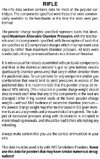So I am working on developing a new load for my M1917 because I got a good deal on 500 of 180gr SMK factory seconds. These perform much differently than the Hornady 178 match bullets I currently use. My question is what are the factors behind the vast differences between these 2 bullets. I noticed the max charge on AA4350 was 55.9gr for the Hornady 178gr match bullet and 60.3gr max for the 180gr SIE SBT. Since the weight is almost exactly the same, then is it the angle of the ogive that dictates how much pressure the bullet can handle? Thanks.
Last edited:


